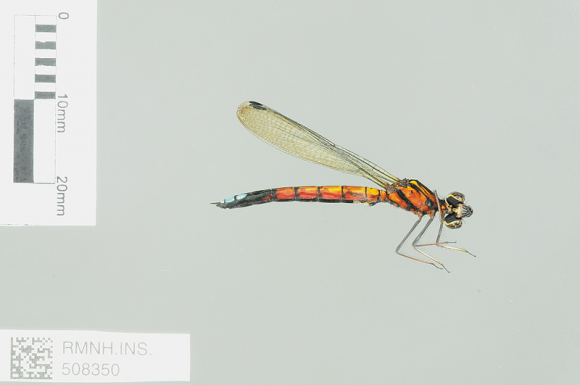Platycypha rufitibia (Pinhey, 1961)
Beautiful Jewel
Type locality: Widdicombe, Cameroon
Diagnosis
Male is distinctive and easily identified by combination of (1) range extending from Cameroon to Angola; (2) relatively large size, Hw 18-21 mm; (2) humeral and metapleural black stripes broad, wider than thickness of hind femur, obscuring pale posthumeral stripe; (3) non-dilated white and reddish tibiae contrasting with dark femora; (4) with at most S1-7 red and S8-10 blue, although S7 and sometimes S8 largely black.
Habitat description
Mostly rivers, but also streams, shaded by or in open areas in forest. Usually with dead trunks or branches, often with a gravelly, sandy and/or soft (like muddy) bottom, and probably submerged roots and/or coarse detritus. From 0 to 800 m above sea level.
Distribution

Male © Andr?® G??nther
 Abdomen (dorsal view) |
Map citation: Clausnitzer, V., K.-D.B. Dijkstra, R. Koch, J.-P. Boudot, W.R.T. Darwall, J. Kipping, B. Samraoui, M.J. Samways, J.P. Simaika & F. Suhling, 2012. Focus on African Freshwaters: hotspots of dragonfly diversity and conservation concern. Frontiers in Ecology and the Environment 10: 129-134.
Barcode specimen(s):

Male; Cameroon, South Province, © Dijkstra, K.-D.B., J. Kipping & K. Schuette

Adult, male; Angola, Uige Province, Loge valley © Dijkstra, K.-D.B.

Adult, male; Angola, Uige Province, Loge valley © Dijkstra, K.-D.B.

Adult, male; Gabon, Haut-Ogoué, route d'Onguila © Mézière, Nicolas

Adult, male; Angola, Uige Province, © Dijkstra, K.-D.B.
Reference
- Pinhey, E.C.G. (1961). Dragonflies collected on an expedition from Rhodesia to Nigeria in 1958. Part 1. Entomologists Monthly Magazine, 96, 256-271. [PDF file]
Citation: Dijkstra, K.-D.B (editor). African Dragonflies and Damselflies Online. http://addo.adu.org.za/ [2024-07-27].

